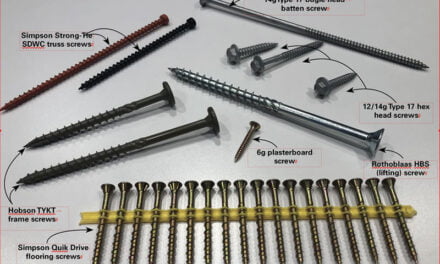We talk to a leading developer about how software is driving the future of timber construction.
Calculations for building with timber were once done with chalk and string. Since then, we’ve seen technology advance through slide rules and calculators to CAD and now 3D modelling. Integrating with machinery, complex modern software is driving the shift to timber offsite construction, making it safer, more economical and more reliable.
From the first quotes, through to final detailing of a project, houses and mid-rise timber structures can exist virtually to allow for precise planning of everything from budgets and timings to connections and services, well before the first piece of timber is cut.
And on the fabricator’s floor, management systems are now guiding the processes well beyond directing cuts and joins, from picking timber to delivery scheduling, increasing productivity and smoothing workflows.
Three big names dominate the Australian market. Multinail’s (www.multinail.com.au) new Cornerstone Project involves a single platform for all models and data associated with a building or project and accurately calculates load transfer from roof trusses, to prefabricated walls to floors, with comprehensive import or input flexibility and easy exporting, all operating with an elegant and accessible interface. The company also offers a paperless Factory Management System that efficiently does exactly what it says on the label.
Pryda’s (www.pryda.com.au) Pryda Build software is a specialist Australian product designed for easy use by fabricators and with strong training and support. The company has close relationship with customers, integrating their feedback into new versions for a results-driven approach.
MiTek’s (www.mitek.com.au) Sapphire allows the design of a whole house or commercial structure as a single entity, automatically translating changes to any one element throughout the structure. Information is easily broken down into elements for each contractor and file sharing is simple. They also supply OptiFlow, a paperless production management system designed to virtually eliminate human error on the floor.
Germany’s SEMA Software (www.sema-soft.de) is also making inroads to the Australian market, and Tapio (www.tapio.one) is offering an evolving software ecosystem that the company envisions as linking all elements of the wood industry value chain.
Clever construction
So what do all these options mean for the average fabricator? We spoke with Richard Moulton, MiTek’s National Software Manager about how the software his company is developing is changing the Australian marketplace.
The first difference is in the complexity of calculations possible these days. “Many years ago, we simply had truss design software,” says Moulton. “These days we have truss, wall, floor design software. It’s all wrapped up in a real 3D model with exact loads generated and passed through all the structural components. Each component is then able to be designed in real time and represented in virtual reality environments on mobile devices such as smart phones and tablets.
“Walls, roof and floor systems don’t work in isolation of each other but until recently, customers used different modules to design these systems. With a fully integrated system, exact loads are known, components that interact with each other are understood and react in a sensible complimentary way, producing fewer errors.”
The calculations take advantage of comprehensive libraries of data for each component, including fasteners, and the results mean an accurate representation of the building can be handed over to the customer or any other stakeholder (including subcontractors) before or after the real building is built.
But the advantages go well beyond the comprehensive model. As Moulton says, “Having a single system, with one interface that is capable of designing most of the structural components is both practical and efficient. When everything is in a single model, we can automate processes and save time.”
This level of sophistication is only possible thanks to the input of specialists with a comprehensive understanding of the processes, who work closely with developers. “This industry is moving towards using ‘designers’ rather than roof experts and wall experts etc.,” says Moulton. “However, it’s also important we allow individual experts to contribute to a single model.”
Software has needed to work with refinements in fabrication over recent years, with the advent of more engineered timbers, more prefabricated systems and more precise fabrication capabilities. At the same time, tolerances in construction are quickly narrowing as building becomes more about assembly, and manufacturers are releasing new products and new systems onto the market.
“I refer to our latest software product Sapphire as being a very ‘honest’ system,” says Moulton. “By this I mean that what we do behind the interface is represent what really happens on site. We really are modelling reality when it comes to objects and fixings and loads, etc. With this in mind, it is generally very easy for us to consider new products, be they timber or steel or possibly some other material and come up with a design solution.”
Helping fabricators
Moulton is excited by the increase in possibilities for the fabricators the company works with. “Fabrication is taking another step forward by fabricating floor systems,” he says. “Taking floor trusses and creating a floor cassette just large enough to transport. These floor cassettes are then craned in on-site, saving valuable on-site time and allowing the builder to achieve an overall faster completion. Wall panels are also increasing in fabrication levels. Customers are supplying fully lined walls with services all included in the fabricated product. Again, the goal here is to save time on-site and to take control of the fabrication process using digital technology and automated manufacturing systems.”
Unusually, MiTek offers a one-stop shop for fabricators, providing software, connections and machinery, with extensive R&D into all aspects. The literal interconnectedness of each component has given the company invaluable insights into their products and where their development should focus. As Moulton says, “The bottom line is that we’ve always listened to what our customers need and our goal has been to serve them fully. By being involved in all aspects of fabrication, we can react quickly, understand problems and deliver solutions.”
The result so far as software is concerned is a hugely customisable product with options numbering in the thousands. “Every option is important to somebody,” says Moulton. “It’s something that means we spend lots of time with customers directly, continually tweaking their systems for best practice solutions. This is not a set and forget system; businesses are living breathing, organisations and changes are continually made which often affect how they might fabricate – which then means changes to the way they use the software.”
But the company isn’t only focused on the new. As Moulton says, “What we’re very flexible with is the rate of take-up of new technology. We find ourselves supporting technology for many years due to the very nature of our business and the gap between early adopters and those wanting to take their time. That said, we’ll be there when they want to move forward or suggest new ideas.”
Management systems
The other side of the business also benefits from MiTek software: a new management system that has a single point of entry and looks after operations across the company.
“With advanced Management tools including workflow, the entire operation can be viewed on custom dashboards showing at what stage a job is at for those that need to know,” says Moulton.
“The levels of customisation allow each business to make this work how they work – using custom tracking points and having great tools like automated email notifications that can be sent to customers or internally to staff to really automate systems and procedures. Automated reports serve up KPIs for the business at certain times to keep the key stakeholders fully informed with what’s going on”
The automated, paperless production processes allow for real-time management recording and analysis systems. “This means we can provide quality feedback to our customers about equipment and workflows that will improve their bottom line,” Moulton says. “Just in time manufacturing, where software and equipment work together with minimal involvement from fabrication staff, is now seen in many operations.”
Virtual to real world
It’s one thing to produce an elegant piece of software design, it’s quite another to have users get the best out of it, as Moulton knows well. “Service and training are at the core of what we do and again technology is helping here,” he says. “A newly developed online MiTek University system delivers rich content for learning our new software products. This provides the know-how to become an experienced designer and the convenience of working through the process at a time that suits you. Managers can also monitor the progress of staff as they work through each step of the process. Of course, we offer in-house training also for those that want the direct experience.”
One of the other difficulties facing developers working in conjunction with leading-edge manufacturers and new products and systems is the possibility of getting ahead of the regulator. “There’s always a balance between new technology and building regulation,” says Moulton. “It’s important we’re well represented on industry boards and regulatory institutions so we can march in synch with evolving trends and new technologies. We have some very smart people who ensure we’re able to help ensure that our customers are best represented.”
With the burgeoning growth of timber in mid-rise structures, fabricators are seizing the opportunity, and Moulton feels a sense of pride in Sapphire’s contribution to this growth. He says, “The depth and breadth of our Sapphire offering is incredible. It’s been a monumental project to get moving and it now has momentum. From my standpoint, seeing this make a difference with our customers is so rewarding.”
Before you invest
While the leading providers in the Australian market all have deservedly strong reputations and provide excellent products, there are several steps to consider when making major software investments.
- Document your needs. Some aspects of business are common to all, but some will be unique to yours. By having a clear description of how you operate, what machinery you have in place, and what you are hoping to achieve with your software choices, potential providers will be able to see how well their products align with your needs.
- Ask to talk with users. There is no better way to see how a program or supplier works than to talk with existing clients, particularly for smaller or newer companies. No sales pitch will ever compete with seeing the product operating on the floor. Many companies will put you in touch with happy customers, others run testimonials on their websites.
When it comes to unhappy customers, it’s a small industry and networking sessions at conferences and association get-togethers can spread the word. That said, get details as to why the experience was a bad one. If there were broken promises, problems with support or failures of the product, that’s a serious red flag. If it didn’t provide the growth the user hoped for, that may have been more of a miscalculation on the user’s side than on the provider’s.
- Does it evolve? Almost every company is looking to grow, and so a software package that is perfect in Year 1 of its installation may be insufficient by Year 5, even if it is well supported with updates.
Look for packages that grow with you, allowing you to increase your commitment or their complexity as your business expands. The best options support transfer of files without loss of data, which will both aid working with clients and other contractors using different systems and give you security if you change your own systems in the future.
Don’t forget the opposite issue: look for companies that also have the confidence and resources to continue supporting older product rather than forcing clients to update constantly.
- Beware the sunk-cost fallacy. Distinct from straightforward sunk costs (which are a separate concern, as are recurring ones), this is the same behaviour that keeps us waiting for a late bus for 20 minutes when our destination is only 10 minutes’ walk away – and it’s all too common in business. If a product is not working the way you had hoped it would, it may not be worth spending a great deal more money and time trying to make it do so if alternatives exist.
- Look for training and support. A good 24/7 helpdesk, remote capabilities, strong training and easily accessed product materials, plus an active product forum is ideal, but can come at a cost. Ongoing support can be a significant part of your investment in a software package, so regularly check that you are using what you are paying for. Make the most of what you spend by taking advantage of all included training and documenting every solution.












